...To name, to make present. If you do not name, you do not have a cultural history, and if you don’t have a cultural history, you do not exist. Everybody understood that. At that time there was only a little writing on lesbian artists like Romaine Brooks and Rosa Bonheur by a few queer art historians who were primarily writing in feminist or gay publications. As editors, we wanted to bring some historical lesbian artists into the magazine to create a conversation about what it meant to be a lesbian artist in the 19th or early 20th century versus now in the context of the WLM. How was it the same and how was it different. How might sexuality affect the work we make?
Harmony Hammond
Download interview in PDF format ![]()
An Interview with Harmony Hammond
March 6, 2011
Harmony’s Studio in Galisteo, New Mexico
Harmony Hammond: My name is Harmony Hammond. We are in my studio in Galisteo, New Mexico where I have lived and worked since 1989, although I moved to New Mexico in 1984. It’s a base from which I engage with different communities. I was a member of the Galisteo Volunteer Fire and Rescue Department for ten years, fought against oil and gas drilling in the Galisteo Basin, and I’m now involved with bosque restoration along the Galisteo Creek. I am active as an artist, curator and critic in the local Santa Fe arts community, as well as national, bicoastal, intergenerational feminist, and queer art communities. I move between these different groups pretty comfortably.
I helped found the feminist art movement in New York in the early 1970s, contributing to and benefiting from the incredible energy that existed at that time. There was a sense of excitement, of making something happen, of creating change. Since then, I have continued making work, writing, teaching, lecturing and contributing to various feminist, lesbian and queer art projects over the years.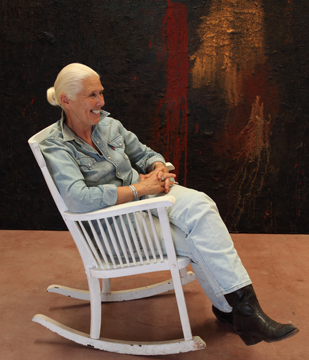
Harmony Hammond in her studio in 2010, photo by Judith Cooper
Carlos Motta: Where did you grow up?
HH: I grew up in Chicago.
CM: Did you identify as a lesbian as a teenager?
HH: No, I didn’t. I grew up in a post-war, lower middle-class housing project; it was all about sameness - row upon row of duplexes. I lived on Main Street in “Hometown.” Luckily, I had an unusual name. I stayed there until I was nineteen and married in order to leave home. I never questioned my sexual identity. At age seventeen I attended Milliken University, a small church school in Decatur, Illinois the soybean capital of the United States because my parents did not want me to go to a big university. That’s where I met Stephen Clover, also an art student, whom I eventually married. He was a year older and from Minnesota, so we moved to Minneapolis and enrolled at the University of Minnesota. This is when my queer personal history began because Steve was gay, but struggling with his sexuality. I did not know. This was the early 1960s, pre gay liberation.
CM: During your marriage did you have any contact with sexually diverse people that had already assumed their sexuality?
HH: Sure, I hung out in gay bars and shopped in gay male clothing stores with Steve. I wore faux leather pants and t-shirts with the sleeves rolled up like Jimmy Dean. I hung out with the boys.
CM: What about with women?
HH: Not really. To be honest, I didn’t have a clue of what was going on. Steve drank, was in therapy trying to deal with his sexuality and eventually came out to me. He thought he was ill and I thought if I could just be a better wife, it would all be okay, and he would get over his illness. This was a very difficult period for both of us because it was pre-gay liberation and there was no support structure. I read Genet’s Our Lady of the Flowers and focused on my artwork. Painting is what got me through it all. Steve was a good person (I say was, because he died from AIDS in the late 1980s); we just should never have been married.
The whole scene was erotically charged. To answer your question, I would hang out with Steve and the boys at their parties. There were some women around - heavy-duty diesel dykes and a few women who passed as men. They thought if he is, then she is, and I was — but didn’t know it. They definitely fascinated me but I never questioned my own sexuality. Hanging out with gay men was safe.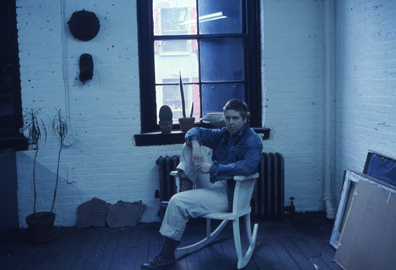
Harmony in her Peal Street studio in NY, 1976. Courtesy of the artist.
CM: When did you move to New York?
HH: Steve and I moved in fall of 1969. The Stonewall Riot was in June 1969 so it was a time of political activism: Civil rights, anti-war protests, as well as the gay and feminist liberation movements. It was also a time when the downtown art world was very experimental.
I came out through the feminist movement. I joined an art CR (Consciousness Raising) group with other women who took their work and themselves very seriously. I was around all these fantastic dynamite women who were discovering and validating women’s lives and histories including their own. It was quite natural to extend our relationships sexually. You know the WLM (Women Liberation Movement) saying, “Feminism is the theory, lesbianism the practice.” That’s kind of the way it was. I am one of many women who came out in the context of the feminist movement. I never went through the pain say that a teenager who thought she might be a lesbian did, before the liberation movements. For me coming out and claiming a lesbian identity was quite pleasurable.
CM: What was your entry into the feminist movement or the art scene?
HH: My friend Brad Davis had already moved from Minneapolis to NYC. Through Brad, I met other artists and dancers. Indirectly through him, I met a couple of women artists who had decided to put together a CR group. We did not have a name; it was not a political action group, but we would participate in feminist art events or political actions. Our group consisting of Louise Fishman, Patsy Norvell, Sarah Draney, Jenny Snider and myself, was interested in consciousness raising. The CR process was about literally going around in a circle and everybody was allotted the same amount of time to speak to whatever topic had been decided upon without being interrupted regardless of what you said. When you were speaking, what you said was taken to be true. We also used the CR process to critique our art. We would go to a different women’s studio each week and focus on that woman’s work. The way we talked about the art was very different than say in art school where content; much less content based on women’s experiences was rarely addressed. In our group, we talked about content in a way that was beyond and not limited to symbolism or iconography.
Most of us worked abstractly coming out post-minimal concerns with materials and process and brought a gender consciousness to that way of working. I have always been very interested in how you bring content into the world of abstraction. I do not think that was unique, but it was very much part of that experimental period in Lower Manhattan. People were experimenting with materials and they did not care what you called it; nobody cared if it was performance, video, dance, painting, or sculpture, you were just doing your thing and could call it this one-day and that another day. 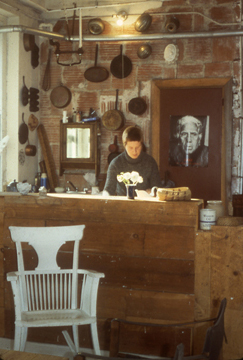
Harmony in studio in NY, 1984. Courtesy of the artist.
CM: Was your group of artists already in conversation with women in other fields also forming the movement?
HH: Sure, we definitely knew feminist writers and activists and one member of our group- Elizabeth Weatherford- was an anthropologist. The art world was small and the feminist art world even smaller. There were very few out lesbians in the art world. I’m thinking of Kate Millett, a sculptor who was outted publically in the broo-ha-ha around the publication of her ground-breaking book Sexual Politics, an11d of Village Voice dance critic Jill Johnston. They are the women who went first and paid a heavy price. The painter Louise Fishman and her partner Esther Newton, an anthropologist, were members of the group, but Esther soon dropped out as the group had a visual art focus.
I read feminist newspapers from all across the country like Country Women, The Lesbian Connection, Ain’t I a Woman and Big Mama Rag. You had to have an opinion about every feminist issue: Feminist credit unions, FBI infiltration, or whether or not to allow male children, or later M to F transsexuals at women’s music festivals. Not only were these huge issues, they really mattered.
CM: What was the relationship between the feminist and the lesbian feminist? Was there a break at some point within the feminist movement and how did this manifest politically?
HH: Well, very early on there were splits in the feminist movement as lesbians demanded recognition. I’m thinking of Betty Friedan famously referring to lesbians as the “lavender menace” or Jill Johnston’s famous lesbian disruption of the Town Hall meeting between Norman Mailer, Jill and several other famous feminists. In the art world it was different. Of course there were others, but Jill was the only publically out lesbian that most people knew of. I myself functioned as a sort of bridge -moving back and forth between groups. I brought an art consciousness to lesbian separatist, socialist feminist or Marxist cadres on the Lower East Side, many of whom were anti-art because they considered art making a bourgeois art world activity, and I brought a political consciousness and a consciousness of sexuality into the art world.
CM: Did you think of yourself as a political person at the time?
HH: Sure.
CM: Or was it just something natural?
HH: I did it naturally but I had full political awareness of what I was doing, absolutely. You don’t take on editing a lesbian issue of a magazine, or organizing a lesbian exhibition unless you have full awareness of the political implications of your actions. 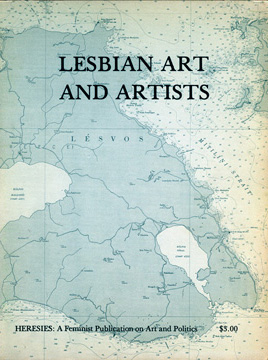
Cover of Heresies "Lesbian Art and Artists" issue
CM: Can you talk to me about some of the strategies that were used both by the feminist movement and the lesbian feminist movement in terms of generating zines, magazines, newspapers, and radical lesbian theories?
HH: Acknowledging and giving value to women’s experiences, lives, labor, and cultures were at the very heart of feminist and lesbian organizing. And making our histories visible. Collectivity and “the means” being as, if not more important than “the end” in terms of organizing. These strategies spilled over into publications. Early position papers and publications such as The SCUM Manifesto, Red Stockings, Women Identified Women, and Our Bodies Ourselves were mimeographed or Xeroxed. Distribution happened at events, readings, and meetings. You had to be present to get a copy, or get a Xerox copy from a friend who had been at the event. There were no women’s bookstores. Once there were women’s bookstores, it all changed. Supporting women’s businesses, say by buying women-authored books at women-owned bookstores, became the political gesture, gradually replacing a more engaged political activism.
CM: How did the feminist magazine Heresies begin?
HH: In the mid-70s, there was this feeling among some feminists in the NYC art world that women artists had become apathetic —settling for a piece of the pie instead of half of the pie, or even questioning the pie. So a word-of-mouth meeting took place at somebody’s loft and we began talking about what we wanted. Two things that came up in the ensuing discussions were a space and a voice. We did not have a physical base or space like feminists in L.A. who had the Women’s Building.
The need for a space turned into the idea for a feminist art school and the desire to have a voice evolved into Heresies: A Feminist Publication on Art and Politics. At first I was involved with both, but it was too much, so I dropped out the school and put all my energy into Heresies. Over the years I was a member of the founding or “mother collective,” worked on three editorial collectives, was office manager for a year or two, and published work in numerous issues.
The “mother collective” consisted of twenty white women ranging in age, who were primarily middle-class and college educated. We represented a range of feminisms: Socialist feminism, cultural feminism, lesbian feminism, etc. My partner Marty Pottenger, a performance artist, and I were the two lesbians in the group. We were soon joined by Su Friedrich and Amy Sillman.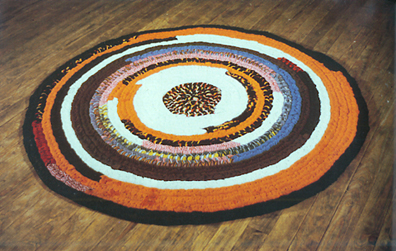
Harmony Hammond, Floor Piece V, 1973
Source: http://www.artnet.com/magazineus/features/saltz/saltz4-23-07_detail.asp?picnum=9
Initially Heresies was to be a quarterly -we were very ambitious. The “mother collective” determined the structure of the magazine, which was quite radical. Each issue had a different theme and a different editorial collective comprised of women from the community as well as women from the “mother collective.” Basically, anyone who wanted to work on a particular issue could. While this structure created many problems, it was what brought life and energy into the publication for so many years. The structure of the magazine tested our belief in a truly open forum for discussion because we had to face the fact that we might disagree with a particular article or even a whole issue, at the same time we supported the magazine.
Marty and I had gotten the collective to agree that the third issue would be on lesbian art and artists. This wouldn’t have happened except that we were there, challenging any assumed heteronormativity and bringing a lesbian perspective to all discussions. This was hugely important because if you look back at the history of the magazine, the fact that the “Mother Collective” was comprised of all white women was a problem. Even though many gestures were made to include women of color as contributors and editors and later as members of the mother collective, it was always difficult because it was after the fact. Eventually there were several issues of the magazine that specifically addressed race, however, had women of color been included from the very beginning, race, like lesbian sexuality would have been part of the discussion.
Marty and I put the word out to see who would be interested in editing the “Lesbian Art and Artists” issue. There were eleven of us. Together, we decided you had to be self identified as a lesbian to be an editor of that issue. We thought that was quite reasonable, but some of the women on the “mother collective” went “bizerk.” They could understand the need for this issue, but were not used to being excluded. Luckily a few of the straight women understood, the political necessity of our decision. 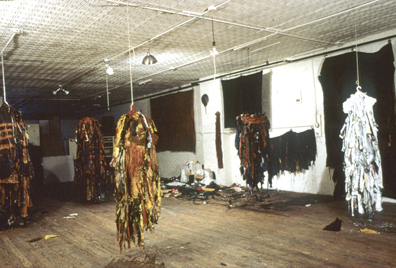
Harmony Hammond's Bowery studio,1973
CM: How did it end up working? Did you then invite other lesbian women to submit material?
HH: Yes, but it was almost as hard as getting lesbians in the art world to work editorially on this issue.
CM: Why would they not want to be associated?
HH: For a number of reasons: They felt that the label “lesbian” would limit how they and their work were viewed if it were included in an issue devoted solely to lesbian art and artists. They feared their work would not be taken seriously, there could be professional repercussions and their careers might suffer, so they did not want to touch it with a ten-foot pole. Some radical lesbian separatists weren’t interested because it wasn’t a lesbian magazine but rather a feminist magazine publishing a lesbian issue, and feared that lesbian material wouldn’t be included in other theme-based issues, Also, there were women who felt they wouldn’t want to be involved with the issue because as lesbian artists their art practice was the only safe space where they dealt with their real feelings -going public would mean giving that up
CM: What was the idea behind the issue? What were the points you were pushing for?
HH: As groundbreaking as it was, by today’s standards the issue appears very safe. For example, there’s no sexual or sexualized images despite the fact that the issue is based on sexual difference that’s partially due to the fact the eleven of us were diverse in age, experience, a112nd politics -there wasn’t one lesbian vision. What we did all agree on was the need to end the silence around lesbian art and artists.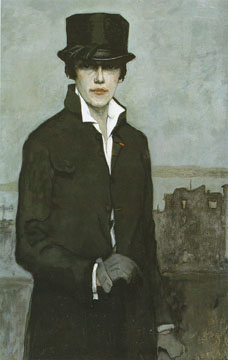
Detail of a self-portrait by Romaine Brooks, 1923
source: http://sexualityinart.wordpress.com/tag/romaine-brooks
CM: You mentioned in your book the necessity to name and to represent lesbian artists as a way of opposing repression.
HH: Right, to name, to make present. If you do not name, you do not have a cultural history, and if you don’t have a cultural history, you do not exist. Everybody understood that. At that time there was only a little writing on lesbian artists like Romaine Brooks and Rosa Bonheur by a few queer art historians who were primarily writing in feminist or gay publications. As editors, we wanted to bring some historical lesbian artists into the magazine to create a conversation about what it meant to be a lesbian artist in the 19th or 20th century versus now in the context of the WLM. How was it the same and how was it different. How might sexuality affect the work we make? Unfortunately, there wasn’t much we could draw on historically and getting contemporary work proved equally difficult.
CM: How was the issue received after publication?
HH: It was very well received at the time. In fact, I still run into to women of all ages who say that issue changed their lives!
CM: What was the theoretical framework you were using with Heresies?
HH: We all knew we wanted the issue it to be beautiful. Some of us wanted it to be really political while others felt that would feed into stereotypes, raising questions of what constituted lesbian stereotypes of lesbian art and visual culture. We did not use the word “queer” then, much less theorize it. It was totally new territory. So the issue didn’t have one theoretical framework. This was what was so challenging.
CM: It was a beginning.
HH: Yes, and it made it so hard Carlos, because it was so raw. Our feminisms differed and how women identified as lesbians was vastly different. This was reflected in the individual editor’s statements in the front of the magazine that replaced the traditional “editorial statement.” 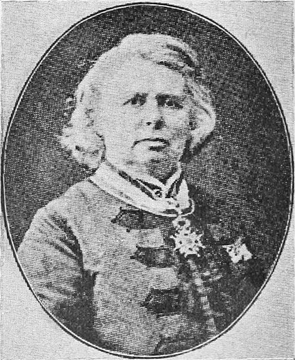
Portait of Rosa Bonheur
Source: http://commons.wikimedia.org/wiki/File:Rosa_Bonheur_photo.jpg
CM: And you personally, what was the framework you were pushing? What was your idea of being a lesbian?
HH: For me it was about self-determination, about being a lesbian artist publicly, about putting the two words, “lesbian” and “artist” together and understanding that as a political gesture. Some of my work dealt with sexuality or with being a lesbian and some of it did not. That has always been true -I have work that is overtly lesbian and then there is work like my current paintings, which to many people’s eyes is not, although some people may do a queer reading. I’ve always operated in that space. I never felt that putting the words “lesbian” and “artist” together was limiting in any way. It’s only a box if you let it be.
CM: Did you think there was a common lesbian sensibility in terms of the formal resolution of a work?
HH: No, not at all. We were looking at work by women who identified as lesbians and as artists to see if there was some thread or commonality of theme, approach, or whatever, but there wasn’t. What did exist was a parallel narrative of lesbian feminist poetry. Lesbian poets were out there and publishing as lesbian poets. Many of the poetry publications also featured photography -primarily documentary photography of women at marches or protests, or doing what would be considered male jobs, women car mechanics, women in the trades, that kind of thing. Photography enabled us to picture ourselves, to literally (re) present ourselves.
Coming out of the lesbian art and artist issue of Heresies, I curated a lesbian art exhibition because on some level I realized there was this extreme “poverty mentality” among many lesbian artists -not the “closeted lesbians” in the art world, but the ones who felt totally outside the art world. They felt marginalized, but also they weren’t supported as artists within their own communities. It’s like they were closet artists.
CM: What do you mean exactly by “poverty mentality”?
HH: Their isolation and outsiderness was not an empowering sense of difference. They were so marginalized and unrepresented culturally with no opportunity to see themselves reflected in the visual culture, much less as cultural producers. 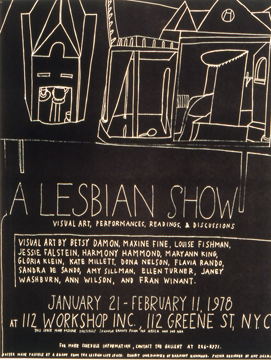
Poster for "A Lesbian Art Show," 1978
CM: What kind of work did you include in “A Lesbian Art Show”?
HH: I didn’t have an agenda. I made studio visits to see what lesbian artists were making. I did the show primarily for the artists so they wouldn’t feel ignored or isolated. I saw it as an opportunity for their work to grow. I also did it to begin generating a lesbian presence within the downtown art world. I wrote a proposal to 112 Greene Street, Jeffrey Lew's not-for-profit workshop space, where then-emerging artists such as Gordon Matta-Clark, Mel Bochner, Louise Bourgeois and Susan Rothenberg were exhibiting. At the time I didn’t know what work was going to be in the show and frankly, in the end, I don’t think the work was that important. The fact that the exhibition existed was important. In the little xerox catalogue that we produced, every artist had a page. Many talked about their fears of showing publicly as a lesbian artist.
CM: Was it a fear of being discriminated by the art world and not being able to exist within the market?
HH: Good heavens, no. Most (but not all) of these artists were totally outside of the art market; they didn’t have anything to lose that way. It was about being public, these women were out in their lives, but this was different. Like I said, art was the one space they where they could openly express themselves. It was a private activity. By participating in the exhibition the work was no longer private. I was taking it out of the closet and installing it in an art space for the entire world to see. There was the fear that they would be judged as artists. In general they felt very vulnerable and isolated as individuals, however by participating in the exhibition they developed a community of lesbian artists and even went on to show together elsewhere. They felt empowered. That word gets overused a lot but the exhibition helped them continue to make work. The turnout for the opening -on a snowy blizzard night- was huge. There was a sense of excitement and exhilaration. We were trespassing in SoHo. At the same time our exhibition poster that was plastered all over the streets of SoHo, was torn down.
CM: The poster by Amy Sillman?
HH: Yes. It was a white line drawing on black -no one could afford color in those days. There was no sexual or sexualized imagery, just the words “Lesbian Show.” We don’t know who ripped down the posters, possibly the truckers who worked in the neighborhood. The show got a lot of critical attention, especially in the gay press. Roberta Smith and others wrote about it. They were very generous. They understood the importance of the exhibition, that it raised the question of how sexual choice, sexuality or same sex desire, might influence or inform works of art, and what the conversation around it might be. They were not heavily critical of the individual works of art because they understood there was something larger happening. 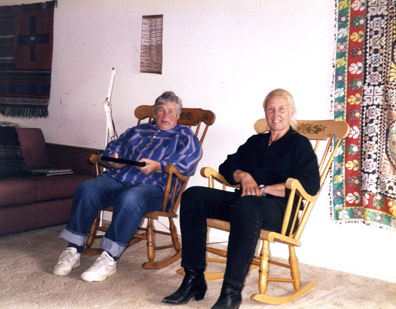
Agnes Martin and Harmony Hammond in the 90s. Photo by Ann Wilson. Courtesry of HH
CM: What was your impression, or the relationship between your group of artists and artists like Agnes Martin or Georgia O’Keeffe? I wonder if there is something about this fear you mention and what for example, Agnes Martin felt about it.
HH: Well Georgia and Agnes were role models. Women artists who made it. The women in my group did not personally know either of them, but of course knew their work. I first met Agnes through Ann Wilson in 1978, but got to know her much better after I moved to New Mexico in 1984. I would never dare speak for Agnes. When I began writing Lesbian Art in America, the parameters of the book were not yet decided. I was considering writing about pre-liberation artists like Agnes and Georgia who were rumored to be bi-sexual or lesbian, or known to have had lesbian relationships. I actually did a lesbian read on some of Agnes Martin’s work but it never got published. Others, like Jonathan D. Katz, have written about it since then.
CM: Did you want to include it in the book?
HH: No, because I had finally decided that Lesbian Art in America would begin with the gay and women’s liberation movements. Interestingly, when I began to write the book I contacted every lesbian artist I knew of. Because I had traveled and lectured I met lesbian artists all across the country so already had a network in place. I sent these artists some exploratory questions, such as: “What women artists are your role models or what work is important to you?” I can’t tell you how many artists wrote back and told me the artist that was their role model was the “lesbian artist Agnes Martin.”
CM: Where did they get this?
HH: Exactly honey! That is the question. They didn’t just say Agnes Martin, the painter or artist Agnes Martin -they said “the lesbian painter or lesbian artist Agnes Martin.” I know enough about Agnes and her life to say that at that time there was no public information regarding Agnes’ sexuality much less any lesbian relationships. It was fascinating, that so many lesbian artists responded the way that they did.
CM: So it came through her work?
HH: I have given this a lot of thought and think there are multiple reasons that Agnes was claimed as a lesbian with such surety! The responding artists did not talk about Georgia the same way. Agnes did not have Stieglitz; there was no male figure in the mystique or history of Agnes Martin, as we knew it. This absence of a heterosexual narrative situated Agnes as a woman alone; she was strong, did it her way, had this Canadian pioneer ruggedness and was a bit crazy. She positioned herself as a spiritual outsider and was a damn good artist. Why shouldn’t we claim damn good artists as one of our own?
CM: Had she come out as a lesbian would her work have been marginalized? Would she have lost her place in the art world?
HH: I don’t think so, but I do not really know. By the time of the liberation movements she was already such an icon within the art world that I don’t think she would have lost her place -but there are people who would probably disagree with me. 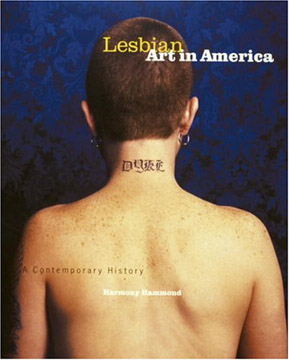
Cover of "Lesbian Art in America" by Harmony Hammond
CM: What decisions did you make in terms of the kind of work you included in the book? I am particularly interested in the idea of figuration versus abstraction. I would like to hear you talk about the potential “transgression” of abstraction that you describe as a coded space to protect the lesbian body from the male gaze.
HH: When I started, I was open to looking at everything. I chose not to deal with the time-based arts because there was already plenty of writing about video and performance and I felt it was not my strength. I included photography however, because it’s tied into the history of lesbian self-representation. Interestingly, one of the criticisms of the book was that there was too much abstract work. This criticism came from lesbian photographers working in portrait and documentary traditions that to date had been privileged in feminist publications. I guess because of my interest in abstraction there was more abstract work than usual. That said, in response to the criticism, I went back and counted the number of photo and photo-based works and found that they outnumbered abstract works. It just points out how people aren’t used to thinking about abstraction in feminist or queer terms.
One of the reasons that I’m interested in abstraction is that it can incorporate a discourse about the body versus say figuration. Figuration is often literally limited by the contours of the physical body and it does not address the body as a social, cultural and political site, which is something that interests me. Obviously there are some figurative artists that engage the body, but a lot of figurative work simply becomes about representation in a very simplistic way —say historical insertion or role reversal- representing a woman in a male role, or a nude man posing as an odalisque. It’s not multi-layered enough for me. I like layers; I like work that participates in multiple narratives, where there can be contradictions, or tensions between things that don’t coexist easily. Abstraction gives me a space to do that. 
Harmony Hammond, Represent Women: A Primer, 2002
Courtesy of the artist
CM: Were you thinking of abstraction as a political gesture?
HH: In terms of my own work, definitely. When I was doing wrapped sculptures I didn’t really relate to any other artwork. I related to Monique Wittig’s The Lesbian Body, and was thinking about the raw sensual muscular interior of the body, and about the idea of making something out of itself, of layering from the inside out. Even before the wrapped sculptures, I thought of abstraction as a political space or site, and consciously working within that space to be a political as well as aesthetic choice. It’s conceptual.
I had also made baskets and woven sandals —in fact included them in my first NYC show at A.I.R. back in January 1973. I was well aware at the time, that if I had been a fiber artist or basket maker, I would not have been allowed to show them in a gallery, not even in a “women’s gallery” but as a painter I could. I was always aware of pushing the boundaries in some way.
For example, having worked with fabric for a number of years, in 1975 I consciously chose to bring my work that already engaged the narrative of women’s traditional arts, back into the modernist painting field. I did a series of small oil and wax paintings that looked as if they had been woven out of paint. In 1976 these paintings were exhibited at the LaMagna Gallery in NYC, along with Collection of Fragments, an ethnographic case and vitrine displaying fabricated clay shards imprinted with basket weaves that set up an abstract dialogue, anticipating the 90s discourse of the museum’s role of collecting, labeling and displaying artifacts in the creation and authentication of an historical narrative. Collection of Fragments functioned to create a narrative of women’s creative practices and place my work within that narrative. By referencing baskets and exhibiting clay shards along with paintings, I was able to take the feminist project of creating a historical narrative of women’s creativity back into the painting field, merging traditional, craft and fine arts in the skin of paint.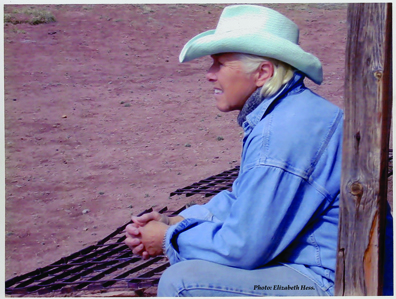
Portrait of Harmony Hammond by Elizabeth Hess, 2005
CM: Your book ends in the 1990s. How do you related to contemporary lesbian art? What is your relationship to artists such as K8 Hardy or Emily Roysdon from LTTR?
HH: I love LTTR. I‘ve met K8, but know Emily, Ginger, and Ulrike better.
CM: Do you think their strategies and the way they are approaching work is indebted to your work?
HH: Absolutely, I think they would say that their work is indebted to second wave feminist art and artists. I consider LTTR to be a descendent of Heresies. These are smart women that understand and embrace the many histories that came before them, feminism being one. At the same time they do it in their own way. I am very interested in their individual and collective practices where there is a slippage around sexuality, gender and gender self-determinacy. It’s not what I do, but I don’t feel separate from it.
CM: A lot of the work that you have done has pointed to and articulated sexual difference, you have recognized it and represented it. One of the things that really worry me about the current climate, especially in mainstream LGBT politics, is the emphasis on equality and sameness over the difference.
HH: That is driving me crazy too Carlos. I do articulate a position of difference. First though, I have to say that I don’t think equality and sameness are the same thing. I believe in equality but not in sameness. The discussion about the politics of difference versus sameness has taken many different forms over the decades. Currently it is focused around the right to same sex marriage. A place where it gets problematic for me, perhaps in the way that you are talking about, is around the whole notion of being “queer.” I like the notion of “queerness” and a queer identity as a fluid continuum of sexualities. But in the last few years, the notion of “queer” has been co-opted. It has become so open that it undermines its radical potential.
Recently, I curated an exhibition of work by queer artists from Texas at Texas State University in Lubbock, intended to create a queer presence and rupture the assumed heteronormativity on campus and around town. Unbeknownst to me, one of the faculty members who had invited me to curate, organized a one-night stand exhibition opening the same night, featuring work “about queer issues by artists of all sexual identities,” most of them straight students performing queerness, or rather their idea of queerness for a night. This meant of course that the work had to “look queer.” Most of the art, based on stereotypes of gender and sexuality, without any examination of these stereotypes, was simplistic, embarrassing and at times downright offensive. To many eyes, the art by real queers in one show didn’t look queer enough but work by heterosexuals in the second show did.
Theoretically, a spin-off exhibition with a differing queer position or in a post-queer spirit could have been interesting, had there been some sort of engaged dialogue between the two shows, but that didn’t happen. One might ask, how did performing queerness for a night give any understanding of non-heteronormative lives, experiences, or cultural production? It’s like straights taking over gay bars and clubs because they’re more fun. If queerness has become so open that anyone can be king, queen, or queer for a night, it means nothing.
